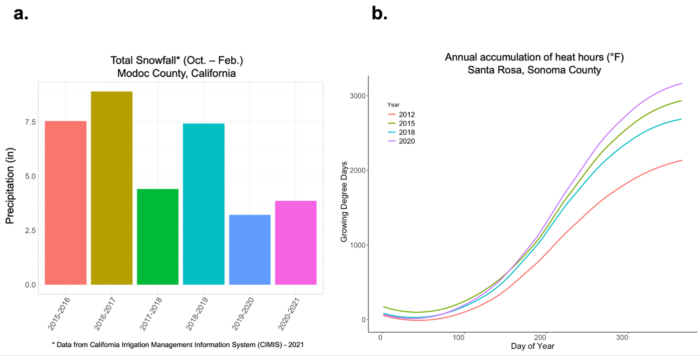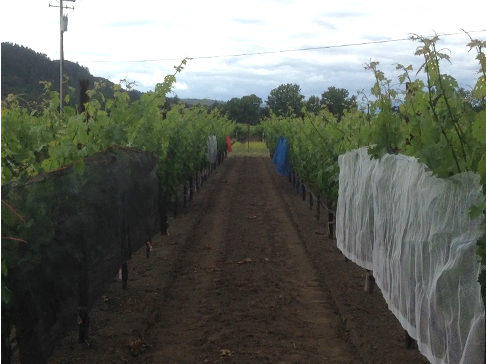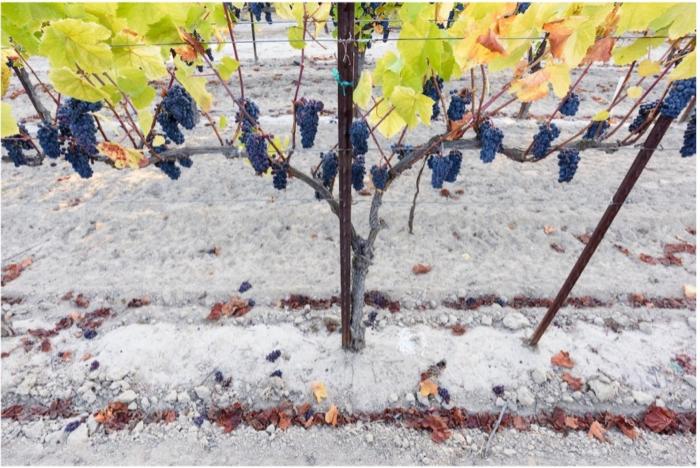January 2022 - Newsletter
January 2022: Wine Without Water – strategies for farming grapes in California’s drought
Christopher Chen – January 2022
Grape growers in California are no strangers to dry and hot conditions. Since 2011 the state has experienced extended drought conditions, record temperatures, and limited precipitation (drought.gov/states/California). However, even with average precipitation in a year the form that it takes and where it falls are as significant to viticulture as how much falls. The irrigation canals that stretch across California are fed by reservoirs that rely heavily on the slow snowpack melt from mountainous regions in the north and east. In regions of the Sierra Nevada range like Modoc, CA, seasonal snowfall has decreased drastically in the past five years (Figure 1a.). Adding to the struggles, annual heat hour accumulation has been on a steady incline in Sonoma County for the past decade (Figure 1b.) and led to higher evapotranspiration and water demand in vineyards. These trends are true across California and have made farming under drought an unwanted reality for many growers.

(a) Total precipitation in Modoc County, California over six years from October to February each year since 2015; (b) Cumulative heat accumulation (linear model) in Santa Rosa, California in 2012, 2015, 2018, and 2020. (source = https://cimis.water.ca.gov)
Viticulture-dominated regions such as Lake County, with around half of its agricultural land planted to grapes is expected to have 25% higher water demand in the next 20 years. In recent years the price per acre-foot of water in California has dramatically increased alongside water demand making viticulture in areas like Lake County less profitable. However, it is generally difficult to put an accurate price on water destined for agriculture [1]. To add to the rising cost of water, labor has also become more costly and less available in the past decade (source = USDA). When observed collectively, hotter and drier conditions in conjunction with increasing costs of water and labor has many grape growers concerned about the future of viable grape production in California.
Facing these mounting concerns, growers and researchers are exploring new and innovative avenues to ensure the legacy of California viticulture continues into the foreseeable future. Assistant Professor Megan Bartlett at the University of California Davis has dedicated her work to optimizing the productivity of vineyards under drought conditions. A plant physiologist by training, Dr. Bartlett has been working to develop grape rootstock and scion varieties that are inherently tolerant to drought. When interviewed, Megan Bartlett made a point to state, “Everything that makes good flavor is the result of a stress, but it is the amount of stress that can result in desirable or detrimental outcomes.” Doctor Bartlett is not alone in this goal. Many researchers across the University of California are looking for methods to better adapt grapevines to drought and provide innovative options to growers. UC Cooperative Extension Vineyard Specialist, S. Kaan Kurtural recently published an article detailing how wine quality ratings from Napa Valley have increased over the past 60 years as temperatures continued to rise in the region [2]. However, Kurtural and co-author Gregory Gambetta caution that it is likely these regions are approaching a “tipping point” at which the grape quality will begin to decline.
“Everything that makes good flavor is the result of a stress, but it is the amount of stress that can result in desirable or detrimental outcomes.”. – Dr. Megan Bartlett
Management practices can help alleviate drought induced stresses in a number of ways. Preemptive management decisions are likely to be most beneficial in the long-term. In the initial planting of vineyards, choosing rootstock cultivars bred for drought tolerance will reduce water consumption on a per vine basis. Rootstocks such as Ramsey and 140 Ruggeri are considered drought tolerant, highly vigorous and can develop deeper reaching roots to seek out water to buffer against prolonged drought better than other rootstock cultivars [3].

Different colored shade nets applied to Cabernet Sauvignon in Oakville, CA in 2017.
However, if replanting a block is not in your near future, seasonal management practices can also help alleviate the stresses of drought. Removing adequate amounts of leaves allows for improved vine water use efficiency by reducing vine transpiration. However, excessive leaf removal can lead to overexposed, sun-damaged fruit. Thinning crop can further alleviate stresses on individual grapevines under water limiting conditions, reducing the amount of crop that ripens and allowing the vine to focus resources on its remaining crop. Maintaining a vine’s balances is always a primary concern when leafing and thinning. Over cropping or over leafing can result in poor quality at harvest regardless of water availability. The use of plastic shading nets [4] as well as particle clays like kaolin [5] can also serve to protect a vine from overexposure and prevent excessive transpiration throughout a day with the former working well under deficit irrigation scheduling.
Among the many decisions grape growers can make to adapt to drought, dry farming is an option for some vineyards in California. The vineyard at Square Peg Winery in Sebastopol, owned and operated by Alex Alper and his family, has been dry farmed for 22 years. Throughout the 12-acre vineyard roughly 8 acres are dry farmed and planted with either Pinot noir or old-vine Zinfandel on St. George rootstock. Square Peg’s vineyard sits on a site with Goldridge soil type where a few feet of sandy loam give way to a thick clay loam deeper in the soil profile. Goldridge soil is highly conducive to dry farming with the clay layer helping to retain water that has leached past the root zone, but is so uncommon in California that Alex stated, “It comes in veins, like gold!” Dry farming grapes comes with a few challenges beyond site selection though. During a sustained drought these sites often heavily thin crop, reducing yields to maintain quality. Alex noted, “The main reason people dry farm is environmentally motivated, but the end product can turn out better than expected.”

Dry farming in Sonoma County, CA at Square Peg Winery’s vineyard requires a sandy soil with rich clay layers beneath. (Image credit = Alex Alper)
As California’s long drought extends into the foreseeable future, techniques for growing grapes in dry conditions will need to be improved and implemented across the state. Management decisions such as selecting deep-rooted, drought tolerant rootstocks when planting and improving irrigation efficiency will greatly benefit drought-impacted viticulture. However, crop and canopy maintenance practices could substantially influence year-to-year outcomes. While California viticulture has not yet reached a tipping point under drought, making decisions that account for less available water will be essential for the grape and wine industry to thrive in a dry climate. Currently, there are many existing options to help growers acclimate to drier conditions, but continued collaboration between growers and researchers is necessary to address the concerns of viticulture and drought.
Christopher Chen
UC Cooperative Extension Advisor - Sonoma, Mendocino, and Lake Counties
Acknowledgements: Interviews and input graciously provided by Dr. Megan Bartlett, Assistant Professor at UC Davis and Alex Alper, Vineyard Manager at Square Peg Winery.
[1] P. D’Odorico, D. D. Chiarelli, L. Rosa, A. Bini, D. Zilberman, and M. C. Rulli, “The global value of water in agriculture,” Proc. Natl. Acad. Sci., vol. 117, no. 36, pp. 21985 LP – 21993, Sep. 2020.
[2] S. K. Kurtural and G. A. Gambetta, “Global warming and wine quality: are we close to the tipping point?,” OENO One, vol. 55, no. 3 SE-Short communications, pp. 353–361, Sep. 2021.
[3] I. Serra, A. Strever, P. A. Myburgh, and A. Deloire, “Review: the interaction between rootstocks and cultivars (Vitis vinifera L.) to enhance drought tolerance in grapevine,” Aust. J. Grape Wine Res., vol. 20, no. 1, pp. 1–14, Feb. 2014.
[4] J. Martínez-Lüscher, C. C. L. Chen, L. Brillante, and S. K. Kurtural, “Mitigating Heat Wave and Exposure Damage to ‘Cabernet Sauvignon’ Wine Grape With Partial Shading Under Two Irrigation Amounts ,” Frontiers in Plant Science , vol. 11. p. 1760, 2020.
[5] L. Brillante et al., “Comparing Kaolin and Pinolene to Improve Sustainable Grapevine Production during Drought,” PLoS One, vol. 11, no. 6, p. e0156631, Jun. 2016.

